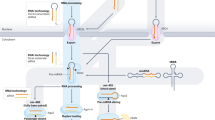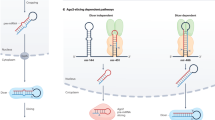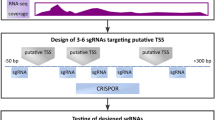Abstract
MicroRNAs (miRNAs) are small noncoding RNAs that repress protein synthesis by binding to target messenger RNAs. We investigated the effect of target secondary structure on the efficacy of repression by miRNAs. Using structures predicted by the Sfold program, we model the interaction between an miRNA and a target as a two-step hybridization reaction: nucleation at an accessible target site followed by hybrid elongation to disrupt local target secondary structure and form the complete miRNA-target duplex. This model accurately accounts for the sensitivity to repression by let-7 of various mutant forms of the Caenorhabditis elegans lin-41 3′ untranslated region and for other experimentally tested miRNA-target interactions in C. elegans and Drosophila melanogaster. These findings indicate a potent effect of target structure on target recognition by miRNAs and establish a structure-based framework for genome-wide identification of animal miRNA targets.
This is a preview of subscription content, access via your institution
Access options
Subscribe to this journal
Receive 12 print issues and online access
$209.00 per year
only $17.42 per issue
Buy this article
- Purchase on SpringerLink
- Instant access to full article PDF
Prices may be subject to local taxes which are calculated during checkout




Similar content being viewed by others
References
Ambros, V. The functions of animal microRNAs. Nature 431, 350–355 (2004).
Bentwich, I. et al. Identification of hundreds of conserved and nonconserved human microRNAs. Nat. Genet. 37, 766–770 (2005).
Boehm, M. & Slack, F. A developmental timing microRNA and its target regulate life span in C. elegans. Science 310, 1954–1957 (2005).
Calin, G.A. & Croce, C.M. MicroRNA-cancer connection: the beginning of a new tale. Cancer Res. 66, 7390–7394 (2006).
Cuellar, T.L. & McManus, M.T. MicroRNAs and endocrine biology. J. Endocrinol. 187, 327–332 (2005).
Brennecke, J., Stark, A., Russell, R.B. & Cohen, S.M. Principles of microRNA-target recognition. PLoS Biol. 3, e85 (2005).
Sethupathy, P., Corda, B. & Hatzigeorgiou, A.G. TarBase: a comprehensive database of experimentally supported animal microRNA targets. RNA 12, 192–197 (2006).
Jones-Rhoades, M.W. & Bartel, D.P. Computational identification of plant microRNAs and their targets, including a stress-induced miRNA. Mol. Cell 14, 787–799 (2004).
Lai, E.C. Predicting and validating microRNA targets. Genome Biol. 5, 115 (2004).
Lewis, B.P., Burge, C.B. & Bartel, D.P. Conserved seed pairing, often flanked by adenosines, indicates that thousands of human genes are microRNA targets. Cell 120, 15–20 (2005).
Doench, J.G. & Sharp, P.A. Specificity of microRNA target selection in translational repression. Genes Dev. 18, 504–511 (2004).
Kiriakidou, M. et al. A combined computational-experimental approach predicts human microRNA targets. Genes Dev. 18, 1165–1178 (2004).
Lewis, B.P., Shih, I.H., Jones-Rhoades, M.W., Bartel, D.P. & Burge, C.B. Prediction of mammalian microRNA targets. Cell 115, 787–798 (2003).
Rajewsky, N. microRNA target predictions in animals. Nat. Genet. 38 Suppl, S8–S13 (2006).
Vella, M.C., Choi, E.Y., Lin, S.Y., Reinert, K. & Slack, F.J. The C. elegans microRNA let-7 binds to imperfect let-7 complementary sites from the lin-41 3′UTR. Genes Dev. 18, 132–137 (2004).
Vella, M.C., Reinert, K. & Slack, F.J. Architecture of a validated microRNA:target interaction. Chem. Biol. 11, 1619–1623 (2004).
Zuker, M. Mfold web server for nucleic acid folding and hybridization prediction. Nucleic Acids Res. 31, 3406–3415 (2003).
Robins, H., Li, Y. & Padgett, R.W. Incorporating structure to predict microRNA targets. Proc. Natl. Acad. Sci. USA 102, 4006–4009 (2005).
Rehmsmeier, M., Steffen, P., Hochsmann, M. & Giegerich, R. Fast and effective prediction of microRNA-target duplexes. RNA 10, 1507–1517 (2004).
Ding, Y., Chan, C.Y. & Lawrence, C.E. Sfold web server for statistical folding and rational design of nucleic acids. Nucleic Acids Res. 32, W135–W141 (2004).
Ding, Y. & Lawrence, C.E. Statistical prediction of single-stranded regions in RNA secondary structure and application to predicting effective antisense target sites and beyond. Nucleic Acids Res. 29, 1034–1046 (2001).
Ding, Y. & Lawrence, C.E. A statistical sampling algorithm for RNA secondary structure prediction. Nucleic Acids Res. 31, 7280–7301 (2003).
Hargittai, M.R., Gorelick, R.J., Rouzina, I. & Musier-Forsyth, K. Mechanistic insights into the kinetics of HIV-1 nucleocapsid protein-facilitated tRNA annealing to the primer binding site. J. Mol. Biol. 337, 951–968 (2004).
Xia, T. et al. Thermodynamic parameters for an expanded nearest-neighbor model for formation of RNA duplexes with Watson-Crick base pairs. Biochemistry 37, 14719–14735 (1998).
Clote, P., Ferre, F., Kranakis, E. & Krizanc, D. Structural RNA has lower folding energy than random RNA of the same dinucleotide frequency. RNA 11, 578–591 (2005).
Seggerson, K., Tang, L. & Moss, E.G. Two genetic circuits repress the Caenorhabditis elegans heterochronic gene lin-28 after translation initiation. Dev. Biol. 243, 215–225 (2002).
Didiano, D. & Hobert, O. Perfect seed pairing is not a generally reliable predictor for miRNA-target interactions. Nat. Struct. Mol. Biol. 13, 849–851 (2006).
Johnston, R.J. & Hobert, O. A microRNA controlling left/right neuronal asymmetry in Caenorhabditis elegans. Nature 426, 845–849 (2003).
Ding, Y., Chan, C.Y. & Lawrence, C.E. RNA secondary structure prediction by centroids in a Boltzmann weighted ensemble. RNA 11, 1157–1166 (2005).
Ding, Y., Chan, C.Y. & Lawrence, C.E. Clustering of RNA secondary structures with application to messenger RNAs. J. Mol. Biol. 359, 554–571 (2006).
Overhoff, M. et al. Local RNA target structure influences siRNA efficacy: a systematic global analysis. J. Mol. Biol. 348, 871–881 (2005).
Schubert, S., Grunweller, A., Erdmann, V.A. & Kurreck, J. Local RNA target structure influences siRNA efficacy: systematic analysis of intentionally designed binding regions. J. Mol. Biol. 348, 883–893 (2005).
Zhao, Y., Samal, E. & Srivastava, D. Serum response factor regulates a muscle-specific microRNA that targets Hand2 during cardiogenesis. Nature 436, 214–220 (2005).
Farh, K.K. et al. The widespread impact of mammalian MicroRNAs on mRNA repression and evolution. Science 310, 1817–1821 (2005).
Enright, A.J. et al. MicroRNA targets in Drosophila. Genome Biol. 5, R1 (2003).
Krek, A. et al. Combinatorial microRNA target predictions. Nat. Genet. 37, 495–500 (2005).
Miranda, K.C. et al. A pattern-based method for the identification of microRNA binding sites and their corresponding heteroduplexes. Cell 126, 1203–1217 (2006).
Cullen, B.R. Viruses and microRNAs. Nat. Genet. 38 Suppl, S25–S30 (2006).
Paillart, J.C., Skripkin, E., Ehresmann, B., Ehresmann, C. & Marquet, R. A loop-loop “kissing” complex is the essential part of the dimer linkage of genomic HIV-1 RNA. Proc. Natl. Acad. Sci. USA 93, 5572–5577 (1996).
Reynaldo, L.P., Vologodskii, A.V., Neri, B.P. & Lyamichev, V.I. The kinetics of oligonucleotide replacements. J. Mol. Biol. 297, 511–520 (2000).
Milner, N., Mir, K.U. & Southern, E.M. Selecting effective antisense reagents on combinatorial oligonucleotide arrays. Nat. Biotechnol. 15, 537–541 (1997).
Kolb, F.A. et al. Bulged residues promote the progression of a loop-loop interaction to a stable and inhibitory antisense-target RNA complex. Nucleic Acids Res. 29, 3145–3153 (2001).
Acknowledgements
We acknowledge the Computational Molecular Biology and Statistics Core at the Wadsworth Center for providing computing resources. This work was supported in part by US National Science Foundation grants DMS-0200970 and DBI-0650991 and US National Institutes of Health grant GM068726 to Y.D., and by US National Institutes of Health grants GM34028 and GM066826 to V.A. We thank F. Slack of Yale University for gifts of plasmids, and A. Lee, G. Ambros and members of the Ambros lab for technical help and advice.
Author information
Authors and Affiliations
Contributions
D.L. and Y.D. designed the algorithm and performed computational modeling of RNA structure and thermodynamics, R.L. and V.A. analyzed lin-41 reporter genes in C. elegans, P.W. performed computational modeling and C.Y.C. developed the web interface.
Corresponding authors
Ethics declarations
Competing interests
The authors declare no competing financial interests.
Supplementary information
Supplementary Fig. 1
Analysis of alternative initiation energy values. (PDF 65 kb)
Supplementary Table 1
Open blocks of nucleotides in lin-41 UTR constructs. (PDF 83 kb)
Supplementary Table 2
Analysis of published microRNA-target interactions. (PDF 54 kb)
Supplementary Table 3
Comparison of folding programs. (PDF 37 kb)
Supplementary Table 4
UTR sequences of lac-Z reporter constructs. (PDF 31 kb)
Supplementary Table 5
Spacer sequences. (PDF 26 kb)
Rights and permissions
About this article
Cite this article
Long, D., Lee, R., Williams, P. et al. Potent effect of target structure on microRNA function. Nat Struct Mol Biol 14, 287–294 (2007). https://doi.org/10.1038/nsmb1226
Received:
Accepted:
Published:
Issue Date:
DOI: https://doi.org/10.1038/nsmb1226



